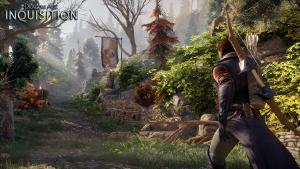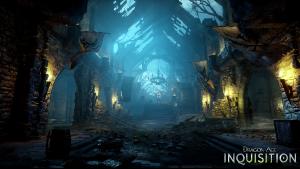
So, with a long-awaited sequel on the horizon, many folks are a bit gun-shy going in. Will it be more like Origins or II? How will the new "open" world play out? Is this going to be The Elder Scrolls VI: Thedas?
Luckily for me, those questions now have tentative answers. I spent a solid five hours and change playing an almost-complete Xbox One version of the game without any adult supervision. I dug into character customization and the early experience, and had ample time to take notes and work through some of my thoughts about Inquisition as it compares not only to its predecessors, but to the other RPGs that have clearly influenced parts of it. Gather your party and venture below, dear reader.
Immediately after selecting new game from the stylish animated title screen, I was presented with a cinematic of my character awakening in what seemed like a Fade-inspired fever dream, complete with the figure of a radiant woman beckoning him forward. From there, it was character creation time. If you've seen the recent videos, you know what to expect here. There's an excellent, robust selection of race and appearance options that allow the player a great deal of control over the countenance their upstart inquisitor will adopt. There are no sliders here, but instead full scaling and detail options, so those of you interested in such things can get that slightly sloped nose bridge you've always dreamed of just right. In addition to the four selectable races of human, dwarf, qunari, and elf, each with male/female options, you'll find the usual slate of Dragon Age classes awaiting your selection: mage, warrior, and rogue.

Once I finished creating my usual character (Taelus the human mage, of course), I found myself thrust into the Frostback Mountains, a snowy hinterland hurled into chaos by the sudden eruption of The Breach, an interdimensional green hole in the sky. Taelus found himself possessed of a strange mark on his hand, one that seemed to share its origin with the gaping maw in the heavens. These two things turn out to be connected somehow, as the mark gives the hero the power to close smaller baby rifts in space and stem the flow of dreamlike Fade demons pouring forth from them. The hope, according to the numerous characters accompanying you early on, is that that same effect can be extended to the granddaddy Breach.
Once I wrapped up the introductory sequence in the mountains, I had access to Haven, the newly-instated Inquisition's home base, where I was able to set my advisors (including series regulars Leliana and Cullen, among others) on various tasks. Need cold hard coin to keep the war effort going? Leliana suggests spying and assassination contracts; Cullen, upstanding former templar he is, advocates sending soldiers out to do honest work like protecting caravans. There were a number of these smaller tasks scattered about the maps of Orlais and Ferelden at my disposal, and while it's too soon to see how big an impact your choice of advisor has on how these events play out, my early impressions are that they go a long way towards making you truly feel more than just a warrior in the battlefield — a battlefield commander also playing the game of politics. Those same maps also allow you to uncover new regions to explore with your combat party, and the first you'll make a foray into are the Hinterlands, a sylvan region awash in autumn tones. Eager to get my adventuring on, I gathered up my party of four and set out.

Immediately apparent in all places is the careful construction and cohesion of the visuals. Gone are the brown basements and cloned scenery of Dragon Age II, and in their place is a world exploding with fabulous use of color. The artwork and character portraits are stylishly drawn, with sharp angles and geometric shapes giving them a regal, Middle Ages-esque feel. The Hinterlands (and other environs beyond that I had a chance to peek at but can't write about yet) bear no marks of copy-pasting. Each portion of these zones, whose size is more reminiscent of Dark Souls than Skyrim, feels hand-crafted and holds rifts to close, dungeons to explore, side quests, and other secrets to uncover. I did get some sense that these big zones with their map icons and checklist items smacked a little too much of AAA "free-roaming" games like Assassin's Creed, Watch Dogs, or Shadow of Mordor, but with the time I've spent thus far it never felt as though I was completing meaningless objectives just to check off a box.
Gameplay instead seems to draw more from the risk/reward of Dark Souls, each area having one main point of ingress, with smaller campsites scattered throughout. Pressing forward to one of these sites unlocks it as a fast travel location, as well as a place to rest and restore potions. On that note, the health system features some great resource management: your party is allotted a certain number of healing potions (eight, in my case), and these are restored upon visiting one of your camps. If you find yourself deep in the wilds and low on potions, you're forced to weigh whether or not you can make it to the top of that hill with the mysterious tower on it and uncover its secrets against simply heading back to camp to rest and refill. This lends itself to a wonderful bit of strategy where fights demand you ration your healing out and truly consider if you can afford to press onward.
Gathering herbs, minerals, and other supplies in the world affords you the ability to create other kinds of potions and weapons, as well as fulfill requisitions for the Inquisition so that they might be better outfitted and foster a strong reputation. Searching out every lost ruin in the Hinterlands lead me to all manner of interesting side stories and hidden treasures. Those treasures were often powerful equipment or components to make the gear I already had even stronger. In this regard, the game handily trumps its predecessor, packing a full inventory system whose scope includes your entire party in play.

As I roamed the hills of the Hinterlands, I came across a story quest to retake a village from warring templars and mages, side quests to stop a local group of uncommonly well-organized and well-armed bandits, and a variety of other interesting events. One especially memorable moment began with me coming out of an underground cave, and a dragon swooping down, smashing rocks off the tops of the hills nearby. Boldly aware of my own prowess, I was most disappointed to discover that my current armor and abilities did little more than scratch the giant beast as he turned me into sizzling barbecue. These types of organic moments seemed fairly common, and they brought me back to the days of Baldur's Gate II and stumbling onto phenomenally powerful dragons who seemed insurmountable, and I found myself eager to power up and return for revenge. The rad music pumping the background sure didn't hurt, either.
Speaking of battling, I was initially a bit puzzled by the combat in Inquisition. It at first appears to be a refined version of the system in Dragon Age II, but the longer I spent with it, the more I began to appreciate how diverse the classes have become and how well-integrated the real-time and tactical elements are. Mages are no longer the damage-dealing murderologists they were in entries past. Instead, with careful use of the tactical camera, I found myself using Taelus to disable and crowd control different enemies, while Cassandra made use of her shield and defensive abilities to "be the wall" between softer party members and foes. One especially awesome attack involves a grappling chain that yanks an enemy to the warrior, and an upgrade rounds out the ability by delivering a stunning kick to the hapless foe. Throwing a point into stealth on dwarven literati slash merchant slash spymaster Varric allowed him not only to smack enemies around with increased damage, but also made him ideal for sneaking in and reviving fallen party members. In fact, the longer I played, the greater the tactical synergy between my party became evident. While it's hard to say how this will play out over the course of the entire adventure, the hours I've already spent with the game have me nodding my head in approval at the game's fusion of the strategic elements of Origins and the action elements of II. And as an added bonus, the tactical camera has enough flexibility to also make for a great photo mode, capturing dramatic shots of your archers flying through the air blasting foes. Bioware: take a page from Sucker Punch and add a button to hide the entire UI.

Aside from my time spent adventuring and doing the things heroes are wont to do, I also engaged in a good deal of chit-chat with the various folks without whose support the Inquisitor would be powerless. Long-time fans will be pleased to see plenty of old faces, and even more pleased to hear of their journeys since last we walked alongside them. Compared to Dragon Age II's very specific, tone-defined responses, there's a great deal more nuance to the chatter in Inquisition. Leliana discusses the "more than friendship but not romantic" relationship shared with Divine Justinia, Threnn the quartermaster tries to convince you that Teryn Loghain Mac Tir was a hero to her and not the villain he's been cast as by history, and Cassandra ruminates over whether or not her choices are the right ones, given her faith. It was truly difficult to tear myself away from the game at the end of my time, because I had very quickly become invested in the various stories these people have to tell. As an added bonus, the game offers options to disable the icons that indicate the tone of a response, allowing the player to role play the words of their dialogue, rather than just follow the "nice-guy path." That said, the tone-specific responses are more diverse than the second game's "snarky, satanic, saintly" black-and-white affair.
So, after several hours exploring Bioware's newest world, do I think it will make headway to reestablishing the good name of this series? The short answer is yes. This is a much tighter, more cohesive, and thoughtfully-produced RPG experience that, so far, seems to take the aspirations of Dragon Age II to have more immediate, exciting play and melds them far more successfully to the tactical, pause-and-issue-commands legacy of Origins. While it's too soon to say if the checklist-y nature of the open world areas will wear out its welcome, I'm at least ready at this point to say that Dragon Age fans should keep their eyes on Inquisition, because it's poised to bring the series back in a wonderful way.